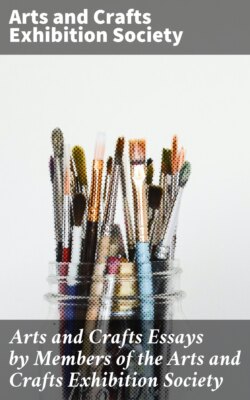Arts and Crafts Essays by Members of the Arts and Crafts Exhibition Society

Реклама. ООО «ЛитРес», ИНН: 7719571260.
Оглавление
Arts and Crafts Exhibition Society. Arts and Crafts Essays by Members of the Arts and Crafts Exhibition Society
Arts and Crafts Essays by Members of the Arts and Crafts Exhibition Society
Table of Contents
PREFACE
OF THE REVIVAL OF DESIGN AND. HANDICRAFT: WITH NOTES ON. THE WORK OF THE ARTS AND. CRAFTS EXHIBITION SOCIETY
TEXTILES
OF DECORATIVE PAINTING AND DESIGN
OF WALL PAPERS
FICTILES
METAL WORK
STONE AND WOOD CARVING
FURNITURE
STAINED GLASS
FOOTNOTES:
TABLE GLASS
FOOTNOTES:
PRINTING
BOOKBINDING
OF MURAL PAINTING
OF SGRAFFITO WORK
OF STUCCO AND GESSO
OF CAST IRON
OF DYEING AS AN ART
OF EMBROIDERY
OF LACE
OF BOOK ILLUSTRATION AND BOOK DECORATION
OF DESIGNS AND WORKING DRAWINGS
FURNITURE AND THE ROOM
OF THE ROOM AND FURNITURE
THE ENGLISH TRADITION
CARPENTERS' FURNITURE
OF DECORATED FURNITURE
OF CARVING
INTARSIA AND INLAID WOOD-WORK
WOODS AND OTHER MATERIALS
OF MODERN EMBROIDERY
FOOTNOTES:
OF MATERIALS
FOOTNOTES:
COLOUR
FOOTNOTES:
STITCHES AND MECHANISM
DESIGN
FOOTNOTES:
ON DESIGNING FOR THE ART OF EMBROIDERY
Отрывок из книги
Arts and Crafts Exhibition Society
Published by Good Press, 2019
.....
In making the above remarks I have been thinking only of the genuine or hand-made carpets. The mechanically-made carpets of to-day must be looked upon as makeshifts for cheapness' sake. Of these, the velvet pile and Brussels are simply coarse worsted velvets woven over wires like other velvet, and cut, in the case of the velvet pile; and Kidderminster carpets are stout cloths, in which abundance of warp (a warp to each weft) is used for the sake of wear and tear. The velvet carpets need the same kind of design as to colour and quality as the real carpets; only, as the colours are necessarily limited in number, and the pattern must repeat at certain distances, the design should be simpler and smaller than in a real carpet. A Kidderminster carpet calls for a small design in which the different planes, or plies, as they are called, are well interlocked.
Mechanical weaving has to repeat the pattern on the cloth within comparatively narrow limits; the number of colours also is limited in most cases to four or five. In most cloths so woven, therefore, the best plan seems to be to choose a pleasant ground colour and to superimpose a pattern mainly composed of either a lighter shade of that colour, or a colour in no very strong contrast to the ground; and then, if you are using several colours, to light up this general arrangement either with a more forcible outline, or by spots of stronger colour carefully disposed. Often the lighter shade on the darker suffices, and hardly calls for anything else: some very beautiful cloths are merely damasks, in which the warp and weft are of the same colour, but a different tone is obtained by the figure and the ground being woven with a longer or shorter twill: the tabby being tied by the warp very often, the satin much more rarely. In any case, the patterned webs produced by mechanical weaving, if the ornament is to be effective and worth the doing, require that same Gothic crispness and clearness of detail which has been spoken of before: the geometrical structure of the pattern, which is a necessity in all recurring patterns, should be boldly insisted upon, so as to draw the eye from accidental figures, which the recurrence of the pattern is apt to produce.
.....